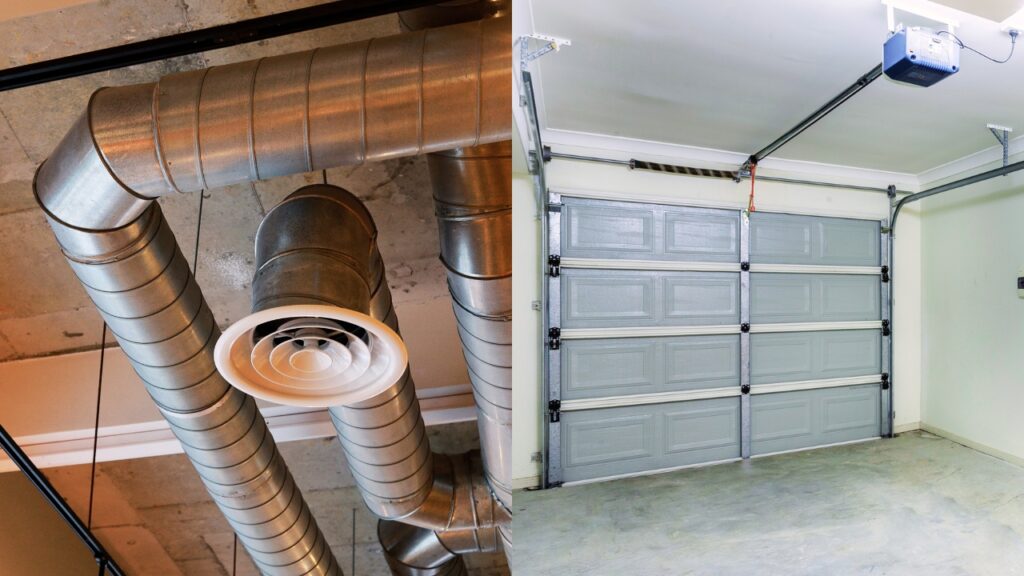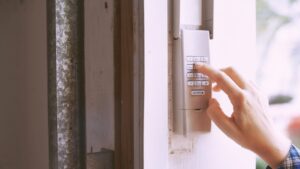Have you ever stepped into your garage and felt you couldn’t breathe? Maybe the air felt thick and stale or hot and humid, even though the weather forecast called for a cooler day. If this is the case, your garage may suffer from poor ventilation, which can significantly impact the indoor air quality of your home.
Poor residential garage ventilation can lead to a buildup of harmful gasses, such as carbon monoxide and volatile organic compounds (VOCs), that can cause various health problems. The lack of airflow can also cause excess humidity and heat, leading to mold growth and potentially dangerous conditions for anyone spending time in the garage.
According to the Environmental Protection Agency (EPA), the levels of VOCs indoors can be 2 to 5 times more than outdoors; in some cases, this difference can be significantly higher. That’s why this guide looks at the importance of indoor air quality and how to ventilate your garage properly.
When Does A Garage Need a Proper Ventilation?
All garages should have proper ventilation to ensure healthy indoor air quality. During hot summer days, the lack of proper ventilation in a garage can create a sauna-like atmosphere that makes it almost unbearable to spend any time there. This can be especially problematic for homeowners who use their garage as a workspace or storage area. Moreover, those considering storing clothes in the garage should be particularly cautious, as the excessive heat and humidity can damage fabrics, leading to mildew or even irreversible spoilage of delicate materials.
In addition to being uncomfortable, excessive garage heat can damage stored items such as paint, chemicals, and even your car. Poor ventilation can also lead to the accumulation of toxic fumes, such as carbon monoxide, which can be deadly if left undetected.
These fumes can enter your home and cause serious health problems, including headaches, nausea, and dizziness.
In colder climates, it’s important to note that ventilation is still necessary even during the winter months, as it can help prevent the buildup of harmful gasses from vehicles or other sources. To determine if your garage needs proper ventilation, it’s important to conduct a thorough inspection.
Watch out for the following signs.
Connect With A Garage Expert
Connect with local experts, Compare quotes, Get the best price.
Undesirable Odor
If you notice any unpleasant odors like chemical smells, gasoline fumes, or musty odors, it could indicate a lack of proper ventilation. A buildup of gasses from vehicles, chemicals, or other sources could cause this. Inspect any appliances or vehicles in your garage for proper ventilation systems.
Consider installing an exhaust fan or ventilation system to help circulate the air and remove any odors.
Excessive Heat
Excessive heat in your garage can make it uncomfortable to spend time in and damage stored items. Check for any signs of excessive heat, such as condensation on the windows or sweat on the walls.
This could be a sign that your garage is not properly ventilated. Consider installing a ventilation system that can help circulate the air and keep the temperature comfortable.
Toxic Fumes
Toxic fumes such as carbon monoxide can accumulate in your garage primarily due to the incomplete combustion of fuels. This can happen when vehicles, lawnmowers, generators, or other equipment that run on gasoline, diesel, propane, or natural gas are operated in an enclosed space without proper ventilation.
Inspect any appliances or vehicles in your garage for proper ventilation systems to help prevent harmful gas buildup. You may also consider installing a carbon monoxide detector in your garage to alert you if levels become too high.
In summary, inspecting your garage for proper ventilation is essential for maintaining a healthy and comfortable living environment in your home. If you notice any signs of poor garage ventilation, such as those listed above, ensure you take action and install a proper ventilation system to help circulate the air and keep your garage safe and comfortable.
Types of Ventilation Systems for the Garage
When considering ventilation options for your garage, it’s important to understand the available options. Each type has its advantages, and they all work to help improve air quality in your home. Here are some of the most popular types:
Natural Ventilation

Natural ventilation is a cost-effective option that utilizes openings such as windows and vents for airflow. This option works best in areas with a mild climate and can be easily incorporated into the design of new garages or retrofitted into existing ones.
However, it may be less effective in areas with extreme temperatures or high pollution levels. This is because it relies on air currents to move the air and has no mechanical or electrical components.
Exhaust Fan

An exhaust fan is a mechanical ventilation system that pulls stale air out of the garage and draws fresh air in. This option is effective in removing fumes and excess heat from the garage. It can be installed through a wall or roof and is relatively easy to use and maintain.
Although this method may help eliminate pollutants, there may be better choices for removing a significant amount. It could be less energy-efficient compared to alternative options, and the main reason for this is that it only works when switched on.
Central Air Systems

Central air systems, commonly known as HVAC systems, provide efficient heating, cooling, and ventilation solutions for garages. These systems use ductwork to circulate air throughout the garage, offering controlled airflow that can be regulated via a thermostat.
While this option effectively improves air quality, it can be costly to install and may only be practical for some garages.
Wall-Mounted Fans

Wall-mounted fans are an affordable option that can easily be installed in the garage. These fans are designed to move large volumes of air, which can help to reduce heat and humidity levels. It’s important to note that wall-mounted fans have some limitations, such as being noisy and possibly less effective at removing pollutants from the air.
Portable Air Purifiers

Portable air purifiers are standalone units that can be used to remove pollutants from the air in the garage. These units use filters to trap particles and can effectively improve air quality, and they are also easy to use and can be moved around as needed.
However, air purifiers may be inefficient in eliminating fumes or excessive heat in the garage. This is because they rely on air passing through the filters to be effective.
When selecting a ventilation system for your garage, it is important to consider all available options before deciding. Depending on your needs and budget, one of these systems may be more suitable than another.
It’s also more important to have a professional install the ventilation system if required. This will ensure it is done correctly and safely, allowing you to enjoy improved air quality and a comfortable garage environment.
How to Ventilate a Garage in 5 Effective Ways
Connect With A Garage Expert
Connect with local experts, Compare quotes, Get the best price.
Once you have chosen the best ventilation system for your garage, it’s time to implement it. If you’re experiencing poor ventilation in your garage, there are a few effective ways to promote better airflow and remove toxic fumes.
Keep in mind that some of these methods may require a significant investment, but the benefits of improved air quality are well worth it.
1. Install an Exhaust Fan
The ideal location for the exhaust fan in a garage is usually near the ceiling or on a sidewall opposite the main entrance or windows. This placement allows for effective air circulation and extraction of fumes, odors, and potentially harmful gases that may accumulate in the space.
It’s also because the exhaust air is heavier than regular air, so pulling it from a spot within 12 inches of the ground is recommended.
Various exhaust fans are available, ranging from small wall-mounted fans to larger ceiling-mounted units. To ensure you get the best fan for your garage, make sure you consider the following factors:
- Airflow rate: The airflow rate of an exhaust fan is measured in CFM (cubic feet per minute). When selecting a fan, choose one with a higher CFM rating to ensure maximum efficiency. The recommended rate of ventilation for a residential garage is 100 cubic feet per minute.
- Noise level: Some fans can be quite noisy, so if noise is an issue, look for a fan with a lower decibel rating. Probably one with between 60dB to 70 dB.
- Size of the area: Make sure you select an exhaust fan sized appropriately for your garage. If the fan is too small, it won’t be able to pull air out of the space effectively.
With these factors in mind, you should be able to find the best exhaust fan for your garage.
2. Add Windows
Adding windows to your garage is another effective way to improve ventilation. Windows allow natural light and fresh air to enter the garage, promoting better airflow and reducing the buildup of heat and fumes.
On the other hand, incorporating windows may be a pricier alternative as it could involve wall cutting, framing installation, and glass mounting. But the benefits are well worth it compared to the investment cost.
The main reasons to add windows to your garage are:
- Reduced air pollution: Windows allow a natural exchange of air, which can help reduce the buildup of pollutants in your garage.
- More light: Incorporating windows can provide more natural light and improved visibility throughout the room.
- Better temperature control: With better airflow, adding windows can help reduce the temperature in your garage.
3. Add Wall Vents
Like most options on the list, wall vents allow air to enter and exit the garage, improving ventilation and reducing the buildup of heat and fumes. They can be installed in various locations around the garage and come in various sizes and styles to suit your specific needs.
When selecting wall vents, make sure to consider the following factors:
- Size: The size of your wall vent will depend on the size of your garage. Make sure you select a big vent to allow for adequate airflow.
- Style: Various styles, from circular grilles to louvered designs, are available. Make sure to select a style that best suits the look of your garage and provides optimal ventilation.
- Material: Wall vents can be made from various materials, including metal and plastic. Choose a durable and stylish material to ensure it meets the elements.
Some benefits of adding wall vents include improved air circulation, reduced humidity levels, and better temperature control.
4. Install Air Conditioning
If you live in an area with extreme temperatures, installing air conditioning may be necessary to maintain a comfortable living environment in your garage. Air conditioning can also help reduce the buildup of heat and fumes, promoting better air quality and reducing the risk of health problems.
On the other hand, the cost of air conditioning installation can be higher as it involves installing a complete system and requires regular maintenance.
5. Upgrade Insulation
Upgrading the insulation in your garage can also help improve ventilation. Poorly insulated garages allow hot air to enter and escape easily, increasing temperatures. Installing quality insulation can reduce the amount of heat entering and exiting the space, resulting in better temperature control.
When upgrading insulation, make sure to choose a material that is designed for garages and meets R-value standards. When selecting an insulation material, it’s also important to consider noise reduction, fire resistance, and moisture control.
6. Routine Maintenance
Routine maintenance is crucial for ensuring the efficient and effective ventilation of a garage. By regularly inspecting and maintaining the ventilation system, you can identify and address any issues before they escalate into more significant problems.
During routine maintenance, it is essential to clean and inspect all components of the ventilation system. This includes checking and cleaning the intake vents, exhaust fans, ducts, and filters. Over time, dust, debris, and other particles can accumulate in these components, obstructing airflow and reducing the system’s efficiency.
Regularly cleaning and removing these obstructions ensures that fresh air can freely enter the garage while stale air is effectively expelled.
Cost of a Residential Garage Ventilation System?
The cost of a residential garage ventilation system can vary depending on several factors, including the size of the garage, the type of ventilation system chosen, and the complexity of the installation.
Here’s a table that provides a general overview of the average range cost for each of the ventilation systems mentioned earlier:
| Ventilation System | Average Range Cost |
| Exhaust Fan | $100 – $500 |
| Windows | $200 – $1000 |
| Wall Vents | $50 – $200 |
| Air Conditioning | $1500 – $5000+ |
| Insulation | $2000 – $6,000+ |
While the cost of installing a proper garage ventilation system may seem significant, it’s important to remember that the benefits of improved air quality and reduced health risks far outweigh the initial investment.
Also, proper garage ventilation can protect your stored items and even increase the value of your home in the long run.
Final Thoughts
In conclusion, a well-ventilated garage is essential for maintaining good indoor air quality and reducing the risk of health problems associated with toxic fumes and excessive heat.
While the cost of installing a garage ventilation system may seem daunting, it’s a worthwhile investment that can protect your health and stored items and even increase the value of your home.
Don’t hesitate to consult a professional contractor to discuss your options and get an accurate estimate for your project.




